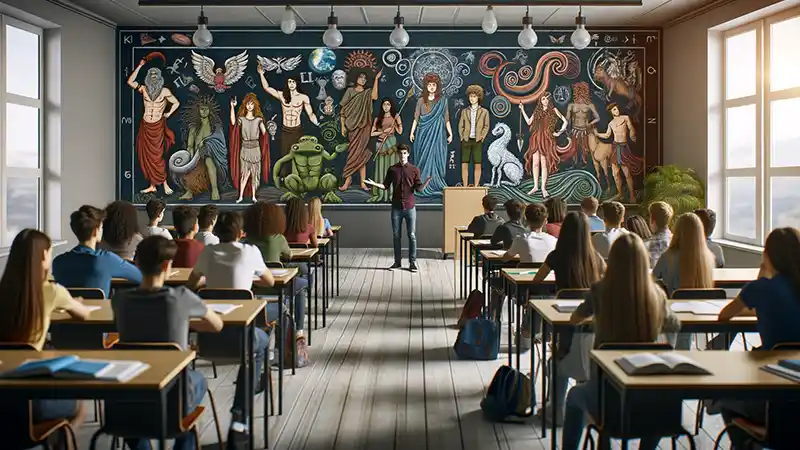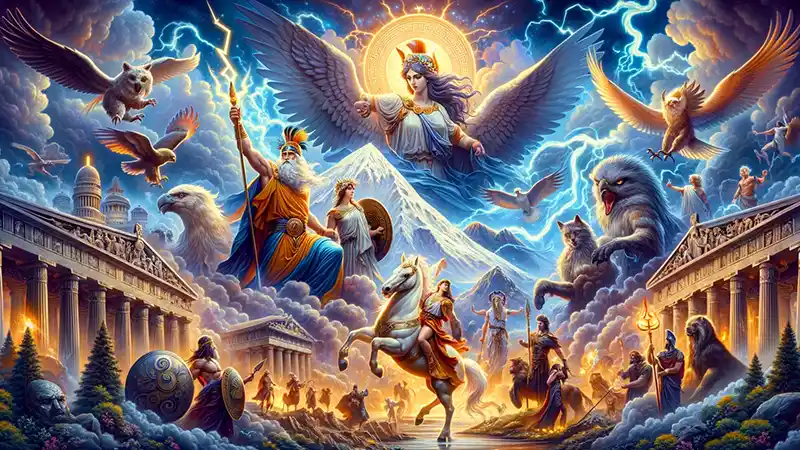Embark on a captivating journey through the ancient world of Greek mythology, where timeless tales of gods, heroes, and mythical creatures await to unfold their profound mysteries. In this interactive lesson, students will immerse themselves in exploring these legendary narratives, each a mosaic of complex emotions, moral dilemmas, and profound symbolism. Groups will choose a myth and unravel its essence by creating an engaging slideshow. From the daring escapades of Perseus and Medusa to the tragic fate of Oedipus Rex, each myth offers a unique glimpse into the ancient Greek psyche and ethos. As they prepare and present, students will recount these fascinating stories and connect them to modern sensibilities, drawing parallels that bridge ancient wisdom with contemporary insights.
Learning Goals
- I will be able to analyze and interpret Greek myths.
- I will be able to communicate ideas clearly through a presentation.
- I will be able to draw connections between ancient myths and modern-day themes.
Materials
- Digital devices for research and to create the slideshow
- Projector for student presentations
Process
- Introduce the myths to choose from
- Let students work in groups of about 3. They can pick which myth to do, but only 1 group per myth.
- Allow one day for prep.
- The next day is for presentations.
Myths to Choose From
- Perseus and the Gorgon Medusa: This myth tells the story of Perseus, the son of Zeus, who is tasked with killing Medusa, a once-beautiful woman cursed with a gaze that turns people to stone. Perseus, aided by gifts from the gods including a reflective shield and winged sandals, successfully beheads Medusa, using her head as a weapon in later adventures.
- Theogony: Written by Hesiod, “Theogony” is a poem describing the origins and genealogies of the Greek gods. It begins with the primordial deities and moves through the generations of Titans and Olympians, detailing their conflicts and relationships, and establishing the framework of Greek mythology.
- Prometheus and the Theft of Fire: This myth revolves around Prometheus, a Titan who defies the gods by stealing fire from Olympus and giving it to humanity. As punishment, Zeus chains Prometheus to a rock where an eagle eternally eats his liver, which regenerates every night, symbolizing the price of human progress.
- The Abduction of Persephone: Persephone, the daughter of Demeter, is abducted by Hades and taken to the underworld to be his queen. Her mother’s grief causes the earth to become barren, leading to the creation of the seasons: Persephone spends part of the year with Hades (winter) and part with her mother (summer).
- Daedalus and Icarus: Daedalus, a master craftsman, creates wings for himself and his son Icarus to escape from Crete. Icarus, ignoring his father’s warnings, flies too close to the sun, melting the wax in his wings, leading to his fall into the sea and death.
- Apollo and Daphne: This myth tells of Apollo, smitten by the nymph Daphne. Daphne, wanting to remain chaste and fleeing Apollo’s advances, prays to her father, a river god, who transforms her into a laurel tree. Apollo then venerates the laurel as his sacred tree.
- Eros and Psyche: Psyche, a mortal woman, becomes the object of the god Eros’s love. Their tale is one of trials and separations, ultimately leading to Psyche’s ascent to Olympus and her transformation into a goddess, symbolizing the union of love and the soul.
- The Three Sisters of Fate: Known as the Moirai, these three sisters — Clotho, Lachesis, and Atropos — control the life thread of every individual. Clotho spins the thread of life, Lachesis measures it, and Atropos cuts it, symbolizing the fate and destiny of mortals and gods alike.
- Narcissus and Echo: Echo, a nymph cursed to only repeat the words of others, falls in love with the beautiful youth Narcissus. Narcissus, however, is obsessed with his own reflection and eventually transforms into a flower. Echo, heartbroken, fades away, leaving only her voice.
- Leda and the Swan: In this myth, Zeus, in the form of a swan, seduces or rapes Leda, the Queen of Sparta. From this union, two eggs are produced, leading to the birth of Helen (later of Troy) and Polydeuces, as well as Castor and Clytemnestra.
- Orpheus and Eurydice: This myth tells of Orpheus, a musician whose music could charm anything, who attempts to retrieve his wife Eurydice from the underworld after her untimely death. Hades agrees under the condition that he not look back at her until they reach the surface, but Orpheus fails to resist, causing Eurydice to be lost to him forever.
- The Myth of Sisyphus: Sisyphus, known for his craftiness, is punished by the gods to eternally roll a boulder up a hill in the underworld, only for it to roll back down each time he nears the top. This story symbolizes the futility of repetitive tasks and the human condition.
- Oedipus Rex: In this tragic myth, Oedipus, the King of Thebes, unknowingly fulfills a prophecy that he would kill his father and marry his mother, leading to disaster for himself and his family. This story is a classic example of Greek tragedy, where fate and a tragic flaw lead to the protagonist’s downfall.
- King Midas and his Golden Touch: Midas, a king with avarice for gold, is granted the wish that everything he touches turns to gold. However, he soon realizes the curse of his wish when his food, drink, and even his daughter are transformed into gold, leading him to beg to reverse his gift.
- Pan and Syrinx: Syrinx, a nymph, is pursued by Pan, the god of the wild. When she is about to be caught, she prays to the river gods and is transformed into reeds. Pan, in his grief, cuts the reeds and makes them into the first pan flute.
- Pandora’s Box: Pandora, the first woman on Earth, is given a box (actually a jar) and instructed not to open it. Overcome by curiosity, she opens it, releasing all the evils into the world but leaving Hope inside when she closes it again.
- The Great Trojan War: Sparked by the abduction of Helen by Paris, the Trojan War is a legendary conflict between the Greeks and the city of Troy. It features famous heroes like Achilles and Hector and is famously chronicled in Homer’s “Iliad”. The war ends with the clever use of the Trojan Horse by the Greeks.
- The Myth of Leto: Leto, a Titaness and lover of Zeus, gives birth to the twin gods Apollo and Artemis. Due to Hera’s jealousy, Leto suffers greatly during her pregnancy and struggles to find a place to give birth, eventually finding solace on the island of Delos.
- The Myth of Niobe: Niobe, proud of her numerous children, boasts about her fertility to Leto, who only has two children. As punishment, Apollo and Artemis kill all of Niobe’s children, and she is turned into a stone, weeping eternally.
- Athena and Arachne: Arachne, a skilled weaver, challenges Athena, goddess of wisdom and crafts, to a weaving contest. Arachne’s hubris and her depiction of the gods’ misdeeds in her tapestry anger Athena, who transforms her into a spider, condemning her to weave forever.
Slide Show Setup
On the slides, use point form notes only! Any lengthy explanations on the slide will be penalized!
Slide 1: Introduction to the Myth
- Title of the Myth: Choose an engaging and descriptive title.
- Brief Overview: Write 2-5 points summarizing the myth.
- Why This Myth?: Share a personal or academic reason for choosing this myth.
Slide 2: Main Characters
- List of Characters: Name the key characters in the myth.
- Character Descriptions: Provide brief descriptions and roles of each character.
- Images/Symbols: Include images or symbols representing each character.
Slide 3: Setting
- Location: Describe where the myth takes place.
- Time Period: Mention the historical or mythical time period.
- Significance: Explain how the setting influences the story.
Slide 4: Plot Overview
- Beginning: Outline the starting situation or problem.
- Middle: Describe the main events and conflicts.
- End: Summarize how the myth concludes.
Slide 5: Major Themes
- List of Themes: Identify 2-3 major themes in the myth.
- Explanation: Explain how these themes are represented in the story.
- Relevance: Discuss the themes’ relevance to today’s world.
Slide 6: Symbolism and Motifs
- Symbols: Identify and explain key symbols in the myth.
- Motifs: Discuss recurring motifs and their meanings.
- Impact: Describe how symbolism and motifs enhance the story.
Slide 7: Personal Reflection
- Personal Connection: Share your thoughts or feelings about the myth.
- Lessons Learned: Discuss any moral or lesson derived from the myth.
- Cultural Impact: Reflect on how the myth influences or reflects Greek culture.
Slide 8: Conclusion and Questions
- Summary: Recap the main points of your presentation.
- Thought-Provoking Question: Pose a question to the audience for discussion.
- Credits: Acknowledge any sources or assistance.
Rubric for Greek Myth Presentation (Total: 20 Marks)
Content Accuracy and Depth (5 Marks)
- (0-1 Mark): Limited or incorrect information, significant inaccuracies.
- (2-3 Marks): Basic information with minor inaccuracies.
- (4 Marks): Mostly accurate and relevant information.
- (5 Marks): Highly accurate, detailed, and relevant information.
Organization and Clarity (4 Marks)
- (0-1 Mark): Disorganized, difficult to follow, lacking clear structure.
- (2 Marks): Some organization, but with unclear transitions or structure.
- (3 Marks): Well-organized, with clear transitions and structured slides.
- (4 Marks): Exceptionally organized, logical flow, easy to follow.
Creativity and Engagement (3 Marks)
- (0-1 Mark): Minimal creativity, fails to engage the audience.
- (2 Marks): Some creative elements, moderately engaging.
- (3 Marks): Highly creative and engaging, holds audience interest throughout.
Use of Visuals and Media (3 Marks)
- (0-1 Mark): Limited or no visuals, poor integration with content.
- (2 Marks): Basic use of visuals that somewhat enhance the content.
- (3 Marks): Effective and relevant visuals/media that enhance understanding.
Understanding of Themes and Symbolism (3 Marks)
- (0-1 Mark): Little to no understanding of themes/symbolism.
- (2 Marks): Basic understanding, but lacks depth or insight.
- (3 Marks): Clear and insightful understanding of themes and symbolism.
Communication Skills (2 Marks)
- (0-1 Mark): Poor communication, hard to understand, lacking confidence.
- (2 Marks): Clear and confident communication, good audience interaction.


